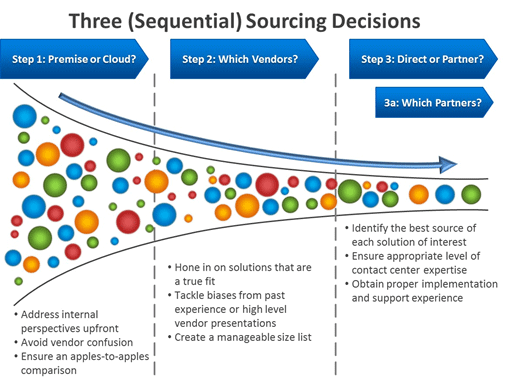If you’ve spent any time around contact center conferences and trade shows, you can’t help but notice that the cloud is all the rage. Cloud-based technology appeals to contact centers that lack sufficient resources to manage their specialized technology. Centers also gain the freedom to turn capabilities and capacity on and off, while continuously benefiting from the vendor’s latest software. And, of course, they fund the solution with operating instead of capital expense, an attractive financial model for many.
Before you get caught up in the cloud fever, you need to start with a basic assessment of “why cloud” for your center. You need to ask: What is our situation? What are our challenges? What are our drivers?
In an ideal world, you’ll make three sequential sourcing decisions. This approach conserves everyone’s precious time and energy by limiting the number of vendors in play, establishing the framework from which to make apples-to-apples comparisons, and keeping the decision process from getting sidetracked (or backtracked)!

The critical first step defines the scope of the project as well as key decision factors on which the team will base its evaluations. It also considers whether a cloud solution is a good fit for the company. An honest self-assessment can surface issues early-on so that they do not become stumbling blocks downstream. For example:
- IT may impose parameters regarding security that impact the decision to go with the cloud, or the type of cloud solution that they’ll find acceptable.
- The team needs to weigh the benefits of the cloud against the desire (or need) to control network connectivity and timing for software upgrades.
- The team (IT and contact center) needs to work with finance to consider the Total Cost of Ownership (TCO) over 3-5 years.
The initial planning phase also affords the opportunity to get educated on the various forms of cloud solutions. The “true cloud” solutions are typically standard offerings delivered on a multi-tenant platform. Others support single tenant solutions; these tend to cost more but offer more customization and control. The team needs to evaluate which option makes the most sense for your circumstances.
At the conclusion of Step 1, you should be clear on the things that really matter (and are non-negotiable) and the things on which you’ll be flexible. You should know which sourcing option you’ll pursue. And you should devise a selection and implementation process that matches the size and scope of the project.
Having set the parameters for the assessment, the team can move to step 2 and narrow its search to the appropriate vendors. Team members may have previous exposure to some vendors and have strong opinions about their offerings. Their perspectives can inform the team as one input while all appropriate options are explored fairly. The end goal should be a manageable list of vendors (e.g., 3-4) for closer examination that all fit the sourcing model and key requirements.
Once the team narrows its interests, the third decision involves determining if you will work with the solution provider directly or engage one of its partners. Vendors have different market strategies and some offer both direct and partner channels. Regardless, the choice should consider the provider’s fit for your size, vertical, and geography, along with their contact center expertise and skilled resources to provide proper implementation and support.
By gaining clarity on your real needs and issues, narrowing the field of inquiry, and orchestrating vendor discussions, you’ll help the team maintain a united front and achieve the excellent results.
Read Cloud Ushers in “New Rules” for Technology Selection for more information »
